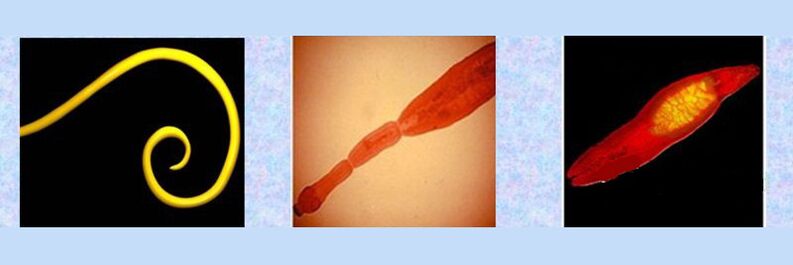- roundworms;
- lucky;
- tape
Characteristics of roundworms

- Pinworm. The most common parasite, it is easily spread from person to person through shared objects. The growth of these nematodes in the body can cause severe discomfort of itching around the anus.
- roundworms. When infected on a large scale, they can be harmful to health. They are worms that can reach a length of 25 centimeters. When mature, the larvae spread throughout the body and internal organs in the blood.
- Trichinella spiralis. These tiny roundworms are up to 5 mm long. They develop in the intestines and give birth to larvae. They then penetrate blood vessels and spread throughout the body.
- Filarial genus. They are mainly found in hot countries and their vectors are insects.
Parasites - Flukes
Flukes enter the body of their final host (humans) through raw or undercooked flesh of carcinogenic species or fish.
- Opisthorchis. People become infected with these parasites by consuming lightly salted or undercooked/undercooked carp or sand fish.
- China's luck. It affects many fish and crustaceans living in Primorye and Japanese waters. The parasite affects the bile and bile ducts, pancreas and liver.
- paragonimiasis. It causes a dangerous disease that affects the lungs, liver, pancreas, kidneys and even the brain. People who eat undercooked freshwater crabs and crayfish can become infected.
- Schistosomiasis. The parasite is usually found in tropical countries, and the larvae actively enter through human skin when swimming and when water from reservoirs enters the mouth.
tape parasites (worms)
- bull tapeworm. It can grow up to 10 meters in length and people become infected by eating beef that has been treated at low temperatures. Housewives sometimes become infected by testing raw minced meat for the amount of added spices or salt. After entering the human body, the larvae turn into saltpeter and adhere to the intestinal wall, causing weight loss, loss of appetite, insomnia, dizziness, etc.
- pork tapeworm. It is small (up to 2 meters long) and can be contracted by eating undercooked pork.
- tapeworm. The length of this parasite ranges from 6-15 meters. It is usually contracted by eating raw freshwater fish. Symptoms such as weakness, vomiting, nausea, and abdominal pain occur.
- Echinococcus. A dangerous parasite that can be contracted from cats and dogs that carry the parasite. In the human body, larvae hatch from eggs and are transported to various organs, especially the liver, along with the blood. Echinococcal cysts subsequently form, which are hazardous to health and require surgical intervention.






































